#ignacio alonso
Explore tagged Tumblr posts
Photo




moa aberg by camilla akrans for vogue italia mar '13 styling by ludivine poiblanc, hair by franco gobbi & ali pirzadeh, makeup by wendy rowe & ignacio alonso
#moa aberg#camilla akrans#ludivine poiblanc#franco gobbi#ali pirzadeh#wendy rowe#ignacio alonso#upload
17 notes
·
View notes
Text

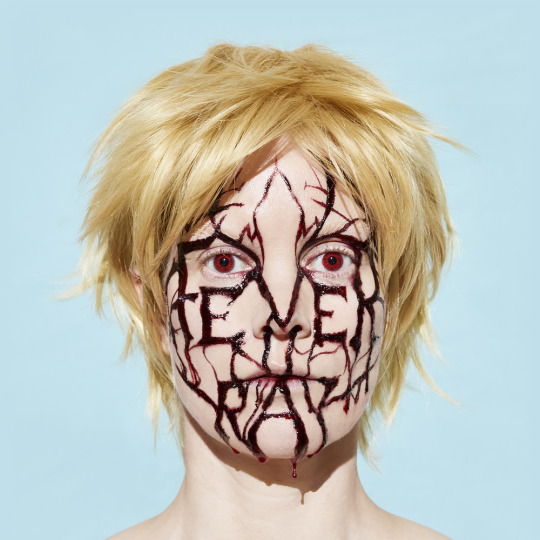




Fever Ray, "Plunge" artwork.
Design Martin Falck / Make-up Ignacio Alonso / Styling Christopher Insulander / Photo Louise Enhörning.
#fever ray#karin dreijer#plunge#cover art#artwork#make-up#photography#martin falck#ignacio alonso#christopher insulander#louise enhörning#2018
3 notes
·
View notes
Text

How about a kiss? For luck?

You have GOT to be kidding...
#Oliver And Company#Ignacio Alonso Julio Federico de Tito#Georgette#screenshots#out of context#Disney
12 notes
·
View notes
Text
Gay dog polycule


That's it thats the post
#'but javi! isnt georgette a woman????' only part time#hashtag bigender georgette#oliver and company#georgette#tito#francis#ignacio alonso julio federico de tito#wait if his name is de tito does that mean hes going by his last name#got three whole fucking names and likes NONE of them#apparently#javi rambles
5 notes
·
View notes
Text
Publicado «El auto del Hombre. A partir de los autos sacramentales de Pedro Calderón de la Barca», de José Luis Alonso de Santos, con prólogo de Ignacio Arellano
Se ha publicado recientemente, a cargo de la Fundación Jorge Guillén y la Universidad de Valladolid, El auto del Hombre. A partir de los autos sacramentales de Pedro Calderón de la Barca, de José Luis Alonso de Santos, con prólogo de Ignacio Arellano: José Luis Alonso de Santos, El auto del Hombre. A partir de los autos sacramentales de Pedro Calderón de la Barca, prólogo de Ignacio Arellano,…

View On WordPress
#Autos sacramentales#Calderón#Calderón de la Barca#Centón literario#El auto del Hombre#Fundación Jorge Guillén#Ignacio Arellano#José Luis Alonso de Santos#Literatura del Siglo de Oro#Siglo de Oro recreado#Teatro del Siglo de Oro#Universidad de Valladolid
0 notes
Text
Del hábito al placer: Libros Recomendados
Hagamos de la lectura un hábito que se convierta en placer. En este artículo comparto con ustedes un listado de libros grandiosos que recomiendo para su lectura, cada uno con sus respectivas reseñas. Libros de temas diversos y de diferentes escritores. Esta lista la estaremos actualizando cada mes, donde compartiremos nuevos libros con sus reseñas y recomendaciones. Espero que puedan…

View On WordPress
#Book#Del Habito a la Lectura#Ignacio Larrañaga#Julio Cesar Valentin#leer#libros#Libros 2023#Libros recomendados#Marco Aurelio#Mario Alonso Puig#Mark Manson#Nelson Mandela#Robert Kiyosaki#Robin Sharma
1 note
·
View note
Text
'The Invisible Truth' Au Characters (Part 2);
The Grandkids:

Luisa Jésica Rojas Madrigal (Partial Owner of the Encanto Animal Sanctuary that she owns with Ryder Nattura and Antonio Madrigal—it also doubles as a vet, thanks to Antonio’s expertise. Dutiful, patient, hard working, loving/kind, good natured, tough, creative, fun loving, athletic, empathic, protective, slightly insecure, selfless, a bit of a peacekeeper, loyal, reliable, anxious/easily stressed, a bit of a caretaker, and an animal lover. Has the gift of superhuman strength. Married to Ryder Nattura and friends with friends with Mariano Guzmán, Inés Guzmán, Enrique Cerebro de Burro, Lydia Guzmán, Débora Guzmán, Bubo Marquez, Lili, Honerymaren Nattura, Elsa Agnarrsdatter, Anna Agnarrsdatter, Luisa Madrigal, Dolores Madrigal, Antonio Madrigal, Hercules, Megara, Vanellope von Schweetz, Mirabel Madrigal, Camilo Madrigal, Mina Preppon, Miguel Rivera, Moana, and Kristoff Bjorgman).
Isabela Alma Rojas Madrigal (Artist, Fencing Instructor, and Owner of Isabela and Bubo’s Oddities Shop—where she sells her art, Bubo’s costumes and special effects, and the plants she experiments with. Rebellious, slightly anxious, protective, creative, loving, slightly tempermatic—usually when people deserve it—, enduring, stubborn, dedicated, loyal, and just unapologetically authentic these days. Has the gift of Chlorokinesis. Married to Bubo Marquez and friends with Mariano Guzmán, Inés Guzmán, Lydia Guzmán, Débora Guzmán, Ryder Nattura, Lili, Honerymaren Nattura, Elsa Agnarrsdatter, Anna Agnarrsdatter, Luisa Madrigal, Dolores Madrigal, Antonio Madrigal, Mirabel Madrigal, Camilo Madrigal, Mina Preppon, Miguel Rivera, Moana, and Kristoff Bjorgman).
Mirabel Valentina Rojas Madrigal (Seamstress and Current Holder of the Miracle. Optimistic, free-spirited, brave, slightly insecure, mature, lively, responsible, friendly, loyal, dutiful, protective, reliable, a bit of a caretaker, somewhat impulsive/reckless, dramatic, playful, quirky, open-minded, empathic, clumsy, humble, honest, and an animal lover. Doesn’t have a gift because she’s the miracle holder. Married to Miguel Julio Rivera and friends with Cipriano Guzmán, Alberto Guzmán, Matias Guzmán, Mariano Guzmán, Bubo Marquez, Elsa Agnarrsdatter, Anna Agnarrsdatter, Luisa Madrigal, Dolores Madrigal, Antonio Madrigal, Camilo Madrigal, Mina Preppon, Honerymaren Nattura, Isabela Madrigal, Moana, Kristoff Bjorgman, Alejandra Isvandi, Melani Isvandi, Juancho Velasquez, Reynaldo Velasquez, Buenavista Bové, Sheyla Bové, Cecilia Bové, Alonso Arias, Ignacio Gracia, and Rio Gracia).
Dolores Adassa Espinosa Madrigal (Writer and Music Teacher. Mature, helpful, quiet, enthusiastic, mischievous, attentive, alert, anxious, great listener, dramatic, bit of a gossip, can be jealous at times, easily stressed/overwhelmed, loyal, creative, well-informed, humble, introverted, romantic, and a sometimes reclusive/judgemental animal lover. Has the gift—and curse—of enhanced hearing. Married to Mariano Guzmán and friends with Cipriano Guzmán, Alberto Guzmán, Matias Guzmán, Bubo Marquez, Elsa Agnarrsdatter, Camilo Madrigal, Mina Preppon, Honerymaren Nattura, Isabela Madrigal, Melani Isvandi, Reynaldo Velasquez, Buenavista Bové, Miguel Rivera, Mirabel Madrigal, Miguel Rivera, Antonio Madrigal, Inés Guzmán, Lydia Guzmán, Débora Guzmán, and Ryder Nattura).
Camilo Pedro Espinosa Madrigal (Drama Teacher, Actor, and Comedian. fun-loving, easy-going, energetic, dramatic, theatrical, playful, kind, friendly, sarcastic, creative, curious, observant, sneaky, flexible/adaptable, resourceful, practical, logical, loyal, realistic, snarky, trusting, extroverted, and a gold hearted mama’s boy. Was married to Yanamaria Maldonado Amaya but they got divorced when he found out she only married him so she and his ex—who she was secretly married to—’s kids could get gifts. He got custody of her twins since he’d adopted them when they got married. He is now married to MIna Preppon and is friends with Mariano Guzmán, Ryder Nattura, Miguel Rivera, Bubo Marquez, Dolores Madrigal, Isabela Madrigal, Antonio Madrigal, Mirabel Madrigal, Hiro Hamada, Alice Liddell, Cipriano Guzmán, Alberto Guzmán, Matias Guzmán, Melani Isvandi, Reynaldo Velasquez, Buenavista Bové, Maui, Moana, Mei Lee,and Luisa Madrigal).
Antonio Bruno Espinosa Madrigal (Partial Owner of the Encanto Animal Sanctuary that he owns with Ryder Nattura and Luisa Madrigal—which also doubles as a vet because of Antonio’s expertise. Sweet, shy, introverted, open minded, compassionate, patient, committed, dutiful, loyal, generous, reliable/responsible, practical, sneaky, flexible/adaptable, resourceful, curious, spiritual, creative, observant, upbeat, and a bit of a chaotic wild child hippie. He is unmarried and unsure if he ever wants to be. He’s friends with Miguel Rivera, Bubo Marquez, Ryder Nattura, Honeymaren Nattura, Benny and Manny Rivera, Kristoff Bjorgman, Alberto Guzmán, Mina Preppon, Dolores Madrigal, Camilo Madrigal, Mirabel Madrigal, Luisa Madrigal, Isabela Madrigal, Alejandra Isvandi, Alonso Arias, Rio Gracia, Juancho Velasquez, Ignacio Gracia,Cecilia Bové, Socorro Rivera, Tarzan, Simea, Pebble, Doc McStuffins, Prince Ralphie, Max La Bouff, Princess Sofia, and Sheyla Bové).
Mariano's Family:


Mariano Rafael Guzmán (Poet and Head Guard of the Encanto. Soft-spoken, eager, shy, romantic, empathetic, generous, lovey-dovey, polite, orderly, good natured, creative, level headed, understanding, reliable, loyal, forgiving, patient, hard working, nurturing, athletic, day dreamer, dedicated {he learned the language of flowers and what different plants symbolize when dating Isabela in an attempt to bond with her, ended up bonding with Bubo too over that and he taught Dolores what different flowers meant when she showed interest}, protective when needed, occasionally unlucky, and a peacekeeper. Married to Dolores Espinosa Madrigal and friendly with mainly everyone but he’s the closest with his in-laws and wife—Bubo Marquez, Kristoff Borgman, Anna Agnarrsdatter, and Ryder Nattura in particular are his best friends).
Señora Rosetta Guzmán (One of the Founders and Head Member of the Planning Committee. Soft-spoken, eager, empathetic, generous, polite, orderly, good natured, level headed, patient, hard working, nurturing, resilient, resourceful, reliable, motherly, kind hearted, loving, prideful, protective, stoic, and a nonsense type of woman. She is unmarried because Mariano’s father, Machello, ran off when he found out she was pregnant. She adopted the rest of her children from the Encanto Orphanage, which she volunteers at. She is friends with Alma, Rosa, Pedro, Benito, Raimi, Alejandra, Alroy, Valentina, Wilmer, and Chandice).
Inés Mila Guzmán (Seamstress at Señora Ozma’s Haberdasher and Tailoring Shop. Dependable, sweet, polite, good natured, humble, patient, hard working, eager, generous, protective, feminine/ladylike, seemingly flawless, dedicated, cultured, calm, charming, Captivating, and a creative good listener. Married to Enrique Cerebro de Burro—Isabela and Dolores helped set them up—and friends with the Madrigals, as well as most of the town).
Lydia Delfina Guzmán (Farmhand. Charismatic, benevolent, aspiring, hardworking, dedicated, protective, generous, tom boyish, sneaky, loving, patient, brash when her siblings need her to be, stoic, resilient, stubborn, reliable, and prideful. She is married to the ‘troubled’ Ana Cerebro de Burro and friends with the Madrigal family and her in-laws).
Débora Elizabetta Guzmán (Doctor. Friendly, outgoing, caring, loud, opinionated, dedicated, tom boyish, loving, maternal, empathic, respectful, open-minded, professional, confident, stubborn, romance adverse, knowledgeable, and a pleasant, stand up, stand out lady. She’s unmarried and doesn’t want to be, and she’s friends with the Madrigal family and her siblings’ partners).
Cipriano Dismas Guzmán (Owner of Cipriano Guzmán’s Toy Shop. Loyal, kind, caring, honest, mischievous, empathetic, dedicated, decisive, open-minded, odd, dramatic, creative, earnest, awkward, ambitious, knowledgeable, warm, charitable, and a bit of a hermit. Married to Buenavista Bové and friends with the Madrigal Family as well as LeFou Deux’s family and his wife’s bandmates. Can’t Stand Camilo’s ex partners and outright banned them from his shop when they came to his shop looking for toys to bribe their kids into coming back home. He thinks they should be banned from the Encanto and voices this opinion whenever they come up).
Alberto Arsenio Guzmán (Owner of a Sweets Shop. Loud, outgoing, friendly, encouraging, open-minded, opinionated, cultured, dutiful, respectful, empathic, honest, trustworthy, protective, and a stand up guy who is a bit wary of his animals but doesn’t outright hate them. He’s unmarried but is open to finding love one day—he’s not overly worried about it though. He’s friends with the Madrigals and knows all of his customers by name).
Matias Stephano Guzmán (Construction Worker. Protective, serious but playful with friends, nurturing, respectful, obedient, emotionally inept, blunt, trustworthy, mature, sweet, prideful, exasperated, hardworking/bit of a workaholic, tough, loyal, reserved, and observant. Married to Nicolás Honoré{Son of Manuela the bake} and friends with his in-laws, siblings, and the Madrigals as well as some of his coworkers.
Machello Bécquer (Miner. Cowardly, selfish, unreliable, evasive, disloyal, apathetic, rude, dishonest, greedy, responsibility–avoidant, abrasive, cynical, disorganized, hardworking, judgemental, boastful, cleverful, cultured, and discreet. Ran off on Rosetta Guzmán when he found out she was pregnant and lost most of the friends he had—no one has heard from him since).
The Grandkids' Partners (Minus Mariano):

Bubo Marquez Madrigal (Artist/Costume Maker, Fencing Instructor, and Owner of Isabela and Bubo’s Oddities Shop. Supportive, creative, playful, nerdy, odd, awkward, shy, snarky, enduring, quirky, street and book smart, loving, dedicated, sentimental, clumsy, crafty/resourceful, reliable, loyal, authentic, family-oriented, somewhat friendly, slightly anxious, fun loving, suave, romantic, eccentric, passionate, enthusiastic, and a somewhat reserved plant and animal lover. Married to Isabela Rojas Madrigal and friends with Mariano Guzmán, Inés Guzmán, Lydia Guzmán, Débora Guzmán, Ryder Nattura, Lili, Honerymaren Nattura, Elsa Agnarrsdatter, Anna Agnarrsdatter, Luisa Madrigal, Dolores Madrigal, Antonio Madrigal, Mirabel Madrigal, Camilo Madrigal, Mina Preppon, Miguel Rivera, Moana, and Kristoff Bjorgman).
Ryder Nattura Madrigal (Partial Owner of the Encanto Animal Sanctuary that he owns with Luisa Rojas Madrigal and Antonio Madrigal and Teacher of the Smiling class at Auradon Prepatory School. Good-natured, easygoing, playful, friendly, quirky, empathetic, adventurous, observant, excitable, observant, naive, playful, helpful, optimistic, loyal, charming, dedicated, harmless, and a mildly tempered animal loving dreamer. He’s married to Luisa Rojas Madrigal and is friends with Bubo Marquez-Madrigal, Mariano Guzmán, Inés Guzmán, Lydia Guzmán, Débora Guzmán, Lili, Isabela Madrigal, Enrique Cerebro de Burro, Ana Cerebro de Burro, Buenavista Bové, Nicolás Honoré, Honerymaren Nattura, Elsa Agnarrsdatter, Anna Agnarrsdatter, Dolores Madrigal, Antonio Madrigal, Mirabel Madrigal, Camilo Madrigal, Mina Preppon, Miguel Rivera, Moana, and Kristoff Bjorgman).
Mina Prepon Madrigal (Handyman and Small-Time Actress. Sarcastic/snarky, hard working, athletic, confident, empathic, tom boyish, passionate, easygoing, reliable, crafty/resourceful, dedicated, authentic, family-oriented, enduring/resilient, observant, helpful, brave, fiery, loving, responsible, knowledgeable, protective, reserved, and strong willed/stubborn. Great niece of Mata from Emperor’s New Groove, ex girlfriend of Kuzco, and she’s married to Camilo Espinosa Madrigal. She’s also friends with Ryder Nattura, Bubo Marquez-Madrigal, Mariano Guzmán, Inés Guzmán, Lydia Guzmán, Débora Guzmán, Lili, Isabela Madrigal, Luisa Madrigal, Isabela Madrigal, Enrique Cerebro de Burro, Ana Cerebro de Burro, Buenavista Bové, Nicolás Honoré, Honerymaren Nattura, Elsa Agnarrsdatter, Anna Agnarrsdatter, Dolores Madrigal, Antonio Madrigal, Mirabel Madrigal, Mina Preppon, Miguel Rivera, Moana, and Kristoff Bjorgman).
Miguel Julio Rivera Madrigal (Famous Musician and Music Teacher. Kind-hearted, family-oriented, enduring/resilient, crafty/resourceful, dedicated/determined, authentic, easygoing, passionate, strong willed/stubborn, aspiring, talented, patient, energetic, rebellious, helpful, loving, mischievous, curious, inspired, outgoing, spontaneous, and a playful dreamer. He’s friends with Ryder Nattura, Bubo Marquez-Madrigal, Mariano Guzmán, Inés Guzmán, Lydia Guzmán, Débora Guzmán, Lili, Isabela Madrigal, Enrique Cerebro de Burro, Ana Cerebro de Burro, Buenavista Bové, Nicolás Honoré, Honerymaren Nattura, Elsa Agnarrsdatter, Anna Agnarrsdatter, Dolores Madrigal, Antonio Madrigal, Mirabel Madrigal, Camilo Madrigal, Mina Preppon, Miguel Rivera, Moana, Kristoff Bjorgman, and the Madrigals in general).
The Grandkids' extremely serious enemies:
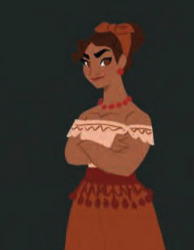

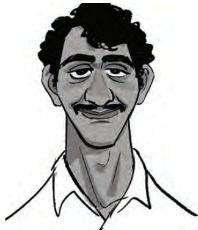
Yanamaria Earlene Maldonado Amaya (Former Stay-At-Home Mom. Two faced, manipulative, deceitful, power-hungry, persuasive, mean, holier than thou, ambitious, alert, observant, good at acting, neglectful, proud, stern, tough, unchanging, demanding, conceited, blunt, discreet, funny ,strong, efficient, and disciplined. Married to Mentiroso Esposito Sosa and friends with Ario Berra Ausentarse—she lost all her other friends when it got out that she had used Camilo to get to the magic and that she tried to flee with Ameila while leaving Sofia behind because of her fear of her power).
Mentiroso Diego Esposito Sosa (Lumberjack. Scheming, weak-willed, playful, sneaky, greedy, blunt, neglectful, discreet, efficient, strong, hard working, callous, childish, disruptive, apathetic, shameful, tempermatic, unassuming, Irresponsible, expectant. and unaccountable. Dated Camilo in highschool and married Yanamaria Maldonado Amaya fresh out of high school—is the one who came up with the plan to use Camilo to get to the magic and now he and his wife only have each other and Ario Berra Ausentarse).
Ario Nereo Berra Ausentarse (Hermit. Questionable, reserved, selfish, thoughtless, funny, lazy, careless, apathetic if things don’t affect him specifically, inconsiderate, gloomy, greedy, indecisive, incurious, insensitive, irritable, and ill-mannered. Dated Camilo shortly after Mentiroso did and is now friendless after abandoning Hugo in an unsafe area, in unsafe weather except for Yanamaria Maldonado Amaya and Mentiroso Esposito Sosa).
Mirabel's generation as adults (Concept Art Edited by Me):
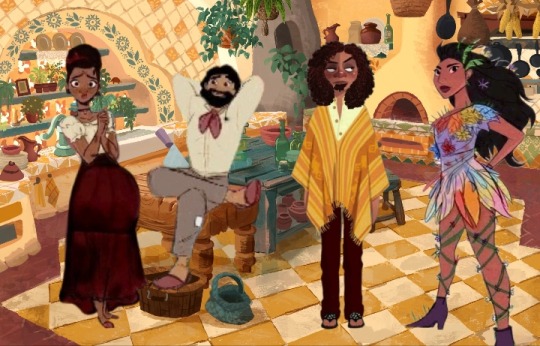



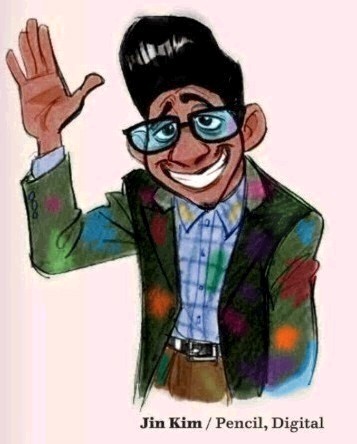
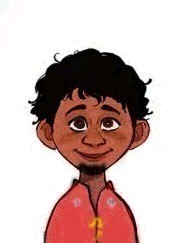

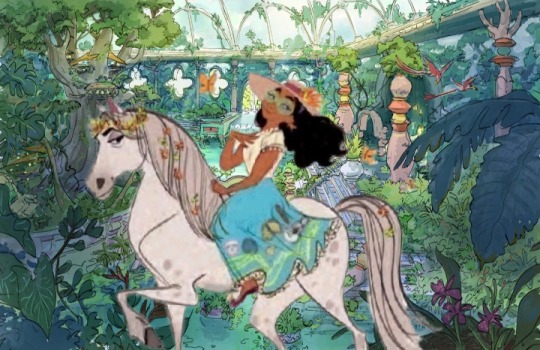
Bruno Madrigal's kids (made in the descendants game 'My Splendid Descendants'):

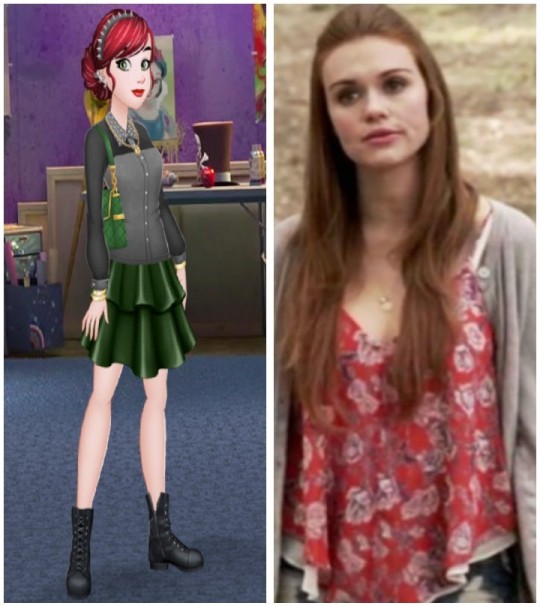

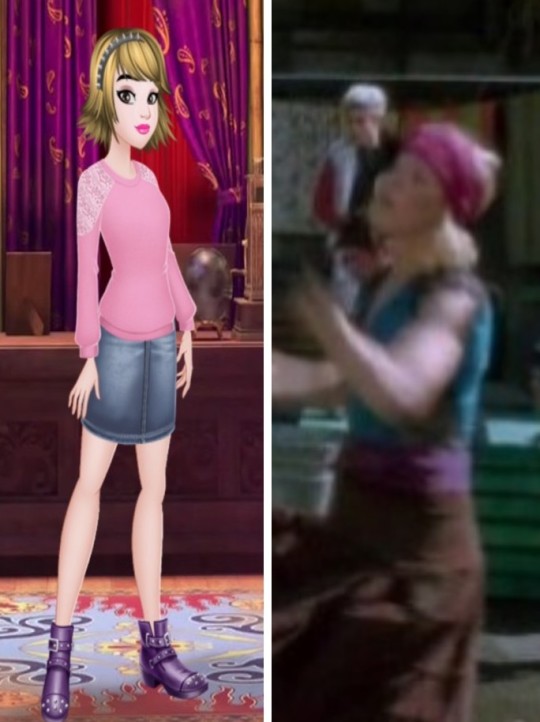

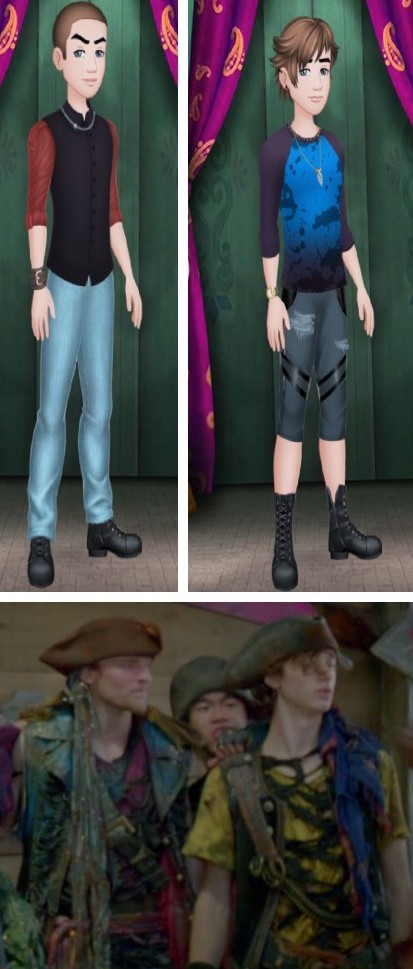

Cesare Bartholomew Colmcille Madrigal Botero (Formerly Frollo)(History Teacher at the Encanto's only public school. Religious but not a fanatic, can come off as holier than thou, calm, gloomy, serious, stern, responsible, conflicted at times, loyal, loving, history lover, analytical, investigative, persistent, tired, protective, and patient. He has the gift of telepathy. Unmarried but is seeing the English Teacher at the school he works at, Araceli Peña Merlo. Friends with his cousins, siblings, his fellow teachers, Carina Potts, Shepherd Scaremonger, Eliza Fae, Jim 'JJ' Brown Jr, Hunter de Vil, Horace the Auradon Prep Liberian, and Señor Flores).
Cornel Thomas Howard Sebastian Madrigal Botero (Formerly Frollo and Formerly Gaskit)(Owner of ‘Encanto’s Gift Baskets’. Introverted, stubborn, religious, protective, knowledgeable, calm, responsible, conflicted at times, patient, creative, guilt ridden, playful, sneaky, rebellious, tired, fair, and dedicated. Has the gift of mediumship. Unmarried but seeing Simon Cantor Acosta Cova, the owner of a shop that sells things relating to cowboys and horses—it’s called ‘Simon’s Western Experience’. Friends with his cousins, siblings, Jim Hawkins, Jane Darling, Carina Potts, Shepherd Scaremonger, Horace the Auradon Prep Liberian, and Princess Melody).
Cyriacus Ignatius Vladimir Madrigal Botero (Formerly Frollo)(Small Time Actor. Introverted, bitter/resentful to an extent, anxious, not religious at all, superstitious, mischievous, rebellious, creative, loving, protective, adaptable, firm, moody, energetic, deceptively intelligent and thoughtful, artistic, and free spirited. Has the gift of prophecy, which was inherited from his mother and not given to him by Casita. Engaged to Amore Pugliese, a sea monster shape shifting who sells imported fabrics in their shop ‘Amore’s Fabric Stop and Shop’. Friends with his siblings, cousins, Ivy de Vil, Eliza Fae, JJ Brown, and most of the Guzmáns).
Claudine Esther Mary Agnes Dymphna Madrigal Botero (Formerly Frollo)(Student, Member of the Queen's Fury—Harriet Hook’s Crew—and Clarinet player of the Bad Apples. Introverted, shy, anxious, artistic/creative, nosey, loving, sneaky, gracious, sweet/kind/fair, multi-talented, giving, intelligent, hardworking, free spirited, animal lover, stubborn, forgiving, and thoughtful. Has the gift of invisibility. Crushing on LeFou Deux Beaumont and is friends with her siblings, cousins, Lefou Deux’s family, Harriet Hook, Anthony Tremaine, Mad Maddy, Clay Clayton, Ginny Gothel, Sammy Smee, Big Murph, Diego de Vil, Jade of Agrabah, Lamar Bones, Chaca, Mako Sharky, Aj Slade, Marya Rasputin, Li Shang Jr, Quinlynn Hearts, Arabella Athanasiou, and Derek Bergmann).
Richard ‘Rick’ Perseus Madrigal Botero (Formerly Ratcliffe)(Student, Member of the Queen's Fury—Harriet Hook’s Crew—and Clarinet player of the Bad Apples. Moody, introverted, protective, aggressive at times, impulsive, caring, nurturing, loud, tired, street smart, animal lover, deceptively good at lying, party animal, edgy, unpredictable, vicious roughhouser, snarky, bit bitter, stubborn, and a bit of a smart ass loner before he met his friends. Has the gift of lie detecting. Crushing on Mad Maddy and friends with his siblings, cousins, Lefou Deux’s family, Harriet Hook, Anthony Tremaine, Mad Maddy, Clay Clayton, Ginny Gothel, Sammy Smee, Big Murph, Diego de Vil, Jade of Agrabah, Lamar Bones, Mako Sharky, Chaca, Aj Slade, Marya Rasputin, Li Shang Jr, Quinlynn Hearts, Arabella Athanasiou, and Derek Bergmann).
Rachel Annelise Madrigal Botero (Formerly Ratcliffe)(Student. Moody, impatient, intolerant of nonsense, somewhat judgemental, stubborn, loving, protective, unapologetically authentic, soft towards those she loves, hard working, street and book smart, multi-talented, athletic, fashionable, aggressive at times, rough, tough, and blunt. Has the gift of sewing animation. Dating Ronaldo Ortiz and friends with her siblings, cousins, their partners, Cailee Beckett, Vidal Pezmuerto, Christopher 'Topher' Thompson, Nora Nattura, Hilda Bjorgman, and an orphaned girl named Annalise from the isle).
Rory Elias Madrigal Botero (Formerly Ratcliffe)(Student. Painfully shy, introverted, skittish, loving, kind, sweet, eccentric, wouldn't hurt a fly, fashionable, history loving, smart, somewhat childish, gentle, helpful, hardworking, sneaky, naive, and superstitious. Has the gift of hindsight. Single. Friends with his siblings and cousins, as well as their friends and partners, and Demurra Foxworth, Cailee Beckett, Elle Athanasiou of Tirulia, and the cheerleaders at Auradon Prep).
Mason Primethorn Gothel (soon to be Madrigal) (Highschool dropout and member of the Lost Revenge crew—Uma’s Crew—who wants to be a botanist. Aggressive, playful, loyal, stubborn, crafty, tricky, shifty, hardworking, sneaky, protective, a bit of a loner when it comes to those outside of his crew, curious, impulsive, and has a bit of a one track mind. Doesn't have a gift but has magic. Single. Friends with everyone in Uma's crew and slowly becoming friends with the Madrigal Family).
Glendale ‘Glenn’ Hazel Gothel (soon to be Madrigal)(Highschool dropout and member of the Lost Revenge crew—Uma’s Crew—who wants to be an astronomer, an astronaut, or a space pirate. Mildly aggressive when roughhousing, playful, loyal, sneaky, hardworking, curious, impulsive, friendly, sensitive, clumsy, bit of a scaredy cat, fun loving, adventurous, and stubborn. Doesn't have a gift but has magic. Single. Friends with everyone in Uma's crew and quickly becoming friends with the Madrigal Family).
Magnolia ‘Gigi’ Marguerite Gothel (soon to be Madrigal)(Student, Former Child Star on ‘Skin Deep With Mother Gothel’, Hair Stylist, Fashion Designer for Evie’s 4 Hearts, Bug Supplier, Hair care products supplier, Auratuber, and Writer and Owner of the two isle magazines ‘Belladona’ & ‘Where The Sun Don't Shine’. Former worker at Mother Gothel's Healing Emporium somewhat against her will. Unassuming, crafty, tricky, shifty, stylish, helpful, playful, sweet, loving, creative, insecure, hardworking, enduring, frail, sickly, mischievous, odd, clumsy, and a smart fan girl who's a bit of a hoarder. Doesn't have a gift but has magic. Crushing on Cailee Beckett and friends with Murky Maggie, Amara Tremaine, Julieanna 'Julie' Foulfellow, Sabina Stromboli, Dizzy Tremaine, Owena, Elizabeth 'Lizard' West, Sad Sally Mim, and is quickly becoming friends with the Madrigal Family).
#encanto#disney descendants#descendants#melissa de la cruz#wicked world#disney descendants au#the invisible truth au#the invisible truth#oc characters#concept art based ocs#encanto concept art#concept art#the madrigal family#alma madrigal#pedro madrigal#the triplets#camilo madrigal#antonio madrigal#mirabel madrigal#isabela madrigal#dolores madrigal#luisa madrigal#mariano guzman#bubo marquez#ryder nattura#miguel rivera#crossover ships#claudine frollo#etc
10 notes
·
View notes
Text
Data of my characters from my space opera thing. if you even care.
Cap. Alberto Ignacio Alonso (Beto)
A Human Rioplatense born in the warm world of Aerolito
Age: 26
Workaholic owner-captain of "Transportes Mastropiero S.A.", which is basically one starship.
Honest, mature for his age, and no-nonsense. He doesn't have time to relax.
Loves learning about other cultures. Spends his piloting time listening to audiobooks about history and astrogeography.
Has done a little bit of everything ever since he was a teen, from driving buses to herding asteroids. Has some odd experiences from all that.
Knows a lot, but more of the intellectual/engineering type. Doesn't have too much time for virtheatres or videogames.
Has a surprising number of exes.
His ring immunizes him from dangers, but does not protect him from sadness.
Raguaturrai of Surrastini (Ragua)
A Irruita (A shark-like species, once the main population of the extinct "Precursor" civilization)
Age: 800? 150.000? 20-something? Who knows? Not her.
A literal fish out of water, found in suspended animation, and possibly the last one of her civilization.
Relaxed, playful, a little irreverent. Very curious about the new world she's in, especially the pop-culture stuff.
Claims she was "a very respected person, someone with a large following drawn to her natural charisma and multifaceted talent"
(she was an idol. not even a very good one.)
Has a strong melancholy and pain for her lost past, but tries to hide it in her playfulness, not-so-succesfully.
Has two pet remoras.
Feels incredibly frustrated that the galactic internet doesn't exist anymore. How is she supposed to stream under these conditions?
Suisini (Suisini)
A Saihisi, a cactus-like photosyntetic species that communicates by changing cromatophore cells.
Age: 43 (at least in this current branch)
A sarcastic, bitter, and a little uncanny engineer. He's in for the money, but nobody knows what he wants it for.
Spends most of his time on his sunroom. Eating sunlight (from diverse lamps).
He manages several drones that take care of the ship's engineering. His cromatophores can print perfect schematics when needed.
Very loyal to the ship, and thus the crew. Probably. He's always worried about something.
Calls himself a he for no apparent reason. Gender is different for Saihisi.
Loves to complain about different kinds of light spectrums.
ANCE Johann Sebastian Mastropiero (La Mastropiero)
(yes, the spaceship is its own character)
A Soledad-Class light military transport manufactured in Astilleros Haedo S.A., Esteloplatense Confederation, during the Machine War.
ANCE stands for Astro-Nave de la Confederación Estelaplatense. While now under civilian ownership, it is still registered to the starcraft carrier ANCE Diego Armando Maradona.
Not very fast, large, or well armed at all, but rugged and easy to pilot, great for doing trade outside of the main aetheric currents.
Saw service on the Machine War in the logistics command of the Allied forces, doing risky transport runs on the Coreward front, piloted by Beto's grandfather.
Sold cheaply as surplus equipment to him after the war, it languished in a hangar on Aerolito until Beto restored it after many jobs (and a rather generous loan by the Astronautic League)
Looks much like the ancient Space Shuttles, painted in celeste and white, with some silver details in fileteado style.
The interior is cozy and spotless. Beto wants the ship to look perfect. It is not minimalistic at all, though; full of little souvenirs from many worlds with a wooden finish.
Has lots of maintance to be done, but keeps them busy all the time. Beto says "un astronauta ocupado es un astronauta feliz". Nobody agrees.
54 notes
·
View notes
Text
EL CRIMINAL PORTUGUES DIEGO DA SILVA
Nuestra querida revista Edra nos trae una historia de superación del Guanarteme Engoynaga contra los invasores portugueses.
EDRA - Origen
FAITA FAITA VIRIRUNJUEN
En el siglo XV (c. 1460-1475) el capitán portugués Diego da Silva intentó invadir la ciudad de Gáldar (Gran Canaria), por el camino quemó poblados y asesinó a sus habitantes; pero derrotado por los canarios a las puertas de la ciudad de Gáldar y sin posibilidad de huir hacia los barcos, se encierra con parte de sus hombres en una amplia construcción hecha por los canarios que se encuentra a la entrada de la ciudad.
En este cerco, Diego da Silva se refugia de la justicia de los canarios durante algunos días en los que se encuentra sitiado por completo, hasta que una noche, el Guanarteme Engoynaga, apiadándose de él y de sus hombres decide perdonarles la vida, y para ello usa una estrategia, entrar con ellos en el cerco…
«A el instante que el rey canario se entró mesclado con los christianos fueron tantas las pedradas i los gritos que parecía día de juiçio no se podían, oir saltaron dentro de el sercado con sus astas, diciendo en su lengua 𝐇𝐚𝐢𝐭𝐚, 𝐡𝐚𝐢𝐭𝐚 𝐯𝐢𝐫𝐢𝐫𝐮𝐧𝐣𝐮𝐞𝐧, “Traición traición, mueran como aleves” o “traidores”, Guadartheme daba grandes voces i mandó que volviessen fuera por onde havían entrado, saliéronse todos, i quedaron otros de pie en la pared, mandolos vajar y tiraban de afuera algunos dardos que lastimaron a algunos soldados, juroles el rey que les quitaría las cavezas por Tis Tirma…».
[Marín de Cubas (1687, I: 37r) 2021: 212]
«[…] viendo la accion los Canarios, que havian suvidose sobre lapared, les tiraron pedradas y palos alos Xristianos con gran vocería, decian 𝐟𝐚𝐢𝐭𝐚, 𝐟𝐚𝐢𝐭𝐚 traicion, mueran los traidores; y luego Guadartheme, les juró por su caveza, que sino se aquietaban les quitaria la Vida, alos demandados».
[Marín de Cubas 1694, I, 16: 32v]
ℹ️ Propuesta de traducción: Faita, faita virirunjen. De Fayəḍ, fayəḍ, birirûn-ǝghǝwăn. “Daño o calamidad a los expatriados que vomitan”. [Ignacio Reyes Garcia (18.IX.2023)].
“El enunciado completo, con el (correcto) ajuste que incluye Marín en la versión de 1694, se restituiría: Faita, faita, virirunjuen o, en su versión analítica, Fayəḍ, fayəḍ, birirûn-ǝghǝwăn.
Por el contexto, donde se demanda la muerte de los extranjeros retenidos, acaso la mejor traducción para el sintagma inicial fayəḍ debería contemplar la literalidad del ‘daño’ que se reclama para ellos (imprecación).
Por lo que respecta a la caracterización de los extranjeros, la imagen que se invoca conjuga dos ideas muy significativas a través de una proposición simple, cabe presumir que lexicalizada. El sujeto expreso remite al nombre plural iburerăn, ‘hombres sin familia ni amigos, alejados de su casa o país’. Individuos que, según reza el verbo (*āhghŭh, *āwghŭh > əqqəw) en su (correspondiente) 3ª persona del plural ǝghǝwăn, ‘vomitan’, bien por la situación de peligro inminente para sus vidas o bien como representación más general de los viajeros que reaccionan así después de una larga travesía (o tal vez en alusión al empleo de las armas de fuego)”.
REFERENCIAS
📖 Tomás Marin de Cubas. Conquista de las Siete Yslas de Canaria (1687). Edición crítica de Antonio M. López Alonso (2021).
🌐 www.proyectotarha.org
🌐 www.imeslan.com
📷 Cuesta de Silva (1893). Fedac. El Guanarteme de Gáldar acompañado de guerreros canarios, imponiéndose a sus vasallos, condujo por la Cuesta de Silva al portugués y a los suyos hasta el lugar en que habían de embarcarse.


Ésta zona de la isla es conocida como el barranco de Silva, el puente de Silva y muchos años atrás como la Cuesta de Silva por lo adbruto del terreno al subir.
http://www.proyectotarha.org/?fbclid=IwAR3Oxplyw9CPYdLG-6gH6lTFFRLFy58vpftisOHkWXtO8VavxP7H62zJxRw
https://www.facebook.com/permalink.php?story_fbid=pfbid0HKCiqp4witNhiwxRMDzTT9ep3UM7qCKyhyGvf62cWsUj1XbxLhMrYnHnuu94e4tHl&id=100046478508495&__cft__[0]=AZUPD2mb9k9iphAvfFcwpRKKSqbViWEso9QIIjZdr-6MQkFAHnZusRR0IGR24CvkXi6RPpyPEowifAnalGbiwbQM0iqeypBmFJvidWJgBlYkj6LgjT2RjdM5M7YnSiyJVZcJaVscJjZfEMoYxGT-WwSQb1KThbYpMv1giCiuupalTp9zPGpth9ORgfjbSIVfXzc&__tn__=%2CO%2CP-R
#diego da silva#portugues#godo#guanarteme#engoynaga#aboriginal#aborigenous#indigenous#culture#history#genocide#native#unesco#united nations#canary islands#international criminal court#cou penal international#corte penal internacional#aborigenes#indigenas#cultura#historia#nativos#genocidio#naciones unidas#islas canarias#canarias la colonia mas antigua del mundo#canarias tiene identidad cultural propia#descolonizacion de canarias#canarias libre
11 notes
·
View notes
Text
2024 olympics Argentina roster
Archery
Mario Jajarabilla (Buenos Aires)
Athletics
Elián Larregina (Suipacha)
Nazareno Sasia (Cerrito)
Joaquín Gómez (Avallaneda)
Belén Casetta (Mar Del Plata)
Florencia Borelli (Mar Del Plata)
Daiana Ocampo (Buenos Aires)
Canoeing
Agustín Vernice (Bahia Blanca)
Brenda Rojas (San Martín De Los Andes)
Cycling
José Torres (Córdoba)
Eduardo Sepúlveda; Jr. (Rawson)
Gonzalo Molina (San Juan)
Equestrian
José Larocca; Jr. (Buenos Aires)
Fencing
Pascual Di Tella (Brooklyn, New York)
Field Hockey
Tomás Santiago (Córdoba)
Juan Catán (Buenos Aires)
Maico Casella (Buenos Aires)
Lucas Toscani (Buenos Aires)
Nicolás Della Torre (Buenos Aires)
Santiago Tarazona (Buenos Aires)
Federico Monja (Vicente López)
Tomas Domene (Córdoba)
Matías Rey (Buenos Aires)
Lucas Martínez (Buenos Aires)
Agustín Mazzilli (Lanús)
Tadeo Marcucci (Buenos Aires)
Thomas Habif (Buenos Aires)
Agustín Bugallo (San Juan)
Bautista Capurro (Buenos Aires)
Iñaki Minadeo (Buenos Aires)
Sofía Toccalino (Buenos Aires)
Agustina Gorzelany (Buenos Aires)
Valentina Raposo (Salta)
Agostino Alonso (Buenos Aires)
Agustina Albertarrio (Adrogué)
María Granatto (La Plata)
Cristina Cosentino (Buenos Aires)
Rocío Sánchez-Moccia (Buenos Aires)
Victoria Sauze (Buenos Aires)
Sofía Cairo (Buenos Aires)
María Trinchinetti (Victoria)
Lara Casas (Buenos Aires)
Juana Castellaro (Buenos Aires)
Pilar Campoy (Vicente López)
Julieta Jankunas (Córdoba)
Zoe Díaz (Buenos Aires)
Soccer
Fabricio Iacovich (La Plata)
Leandro Brey (Lomas De Zamora)
Rocco Ríos-Novo (Los Angeles, California)
Marco Di Cesare (Mendoza)
Valentín Barco (Veinticinco De Mayo)
Roberto García (Liniers)
Nicolás Valentini (Junín)
Aaron Quirós (Monte Grande)
Gonzalo Luján (Buenos Aires)
Lucas Esquivel (Santa Fe De La Vera Cruz)
Federico Redondo (Adrogué)
Cristian Medina (Moreno)
Thiago Almada (Ciudadela)
Claudio Echeverri (Resistencia)
Juan Sforza (Rosario)
Juan Nardoni (Nelson)
Ignacio Fernández (Buenos Aires)
Pablo Solari (Arizona)
Luciano Gondou (Rufino)
Abiel Osorio (Buenos Aires)
Francisco González (Ordóñez)
Santiago Castro (Ciudad Del Liberator General Don José De San Martín)
Golf
Emiliano Grillo (San Diego, California)
Alejandro Tosti (Gainesville, Florida)
Handball
Andrés Moyano (Mendoza)
Nicolás Bono (Buenos Aires)
Federico Fernández (Buenos Aires)
Federico Pizarro (Buenos Aires)
Pablo Vainstein (Buenos Aires)
Diego Simonet (Vicente López)
Pablo Simonet (Vicente López)
Ignacio Pizarro (Lanús)
Santiago Baronetto (Buenos Aires)
Lucas Moscariello (Buenos Aires)
Guillermo Fischer (Buenos Aires)
Pedro Martínez (Buenos Aires)
Gastón Mouriño (Buenos Aires)
James Parker; Jr. (Ciudad San Luis)
Leonel Maciel (Morón)
Nicolás Bonanno (Marcos Paz)
Juan Bar (Vicente López)
Judo
Sofia Fiora (Buenos Aires)
Pentathlon
Franco Serrano (Buenos Aires)
Rowing
Alejandro Colomino (Buenos Aires)
Pedro Dickson (Buenos Aires)
Sonia Baluzzo (Buenos Aires)
Evelyn Silvestro (Zárate)
Rugby
Tomás Elizalde (Buenos Aires)
Agustín Fraga (Buenos Aires)
Matteo Graziano (Buenos Aires)
Alejo Lavayén (Buenos Aires)
Joaquín Pellandini (Buenos Aires)
Tobías Wade (Buenos Aires)
Santiago Álvarez (Bahía Blanca)
Luciano González (La Rioja)
Santiago Mare (Buenos Aires)
Marcos Moneta (Buenos Aires)
Matías Osadczuk (Buenos Aires)
Germán Schulz (Córdoba)
Gastón Revol (Córdoba)
Sailing
Francisco Saubidet (Buenos Aires)
Mateo Majdalani (Buenos Aires)
Francisco Guaragna (Rufino)
Chiara Ferretti (Buenos Aires)
Catalina Turienzo (Buenos Aires)
Eugenia Bosco (Buenos Aires)
Lucía Falasca (Buenos Aires)
Shooting
Marcelo Gutiérrez (Buenos Aires)
Federico Gil (Buenos Aires)
Fernanda Russo (Córdoba)
Skateboarding
Matias Dell Olio (Mar Del Plata)
Mauro Iglesias (Buenos Aires)
Swimming
Ulises Saravia (Buenos Aires)
Agostina Hein (Buenos Aires)
Macarena Ceballos (Río Cuarto)
Table tennis
Santiago Lorenzo (Buenos Aires)
Taekwondo
Lucas Guzmán (Merlo)
Tennis
Sebastián Báez (Buenos Aires)
Francisco Cerúndolo (Buenos Aires)
Tomás Etcheverry (La Plata)
Mariano Navone (Nueve De Julio)
Máximo González (Tandil)
Andrés Malteni (Buenos Aires)
María Carlé (Tandil)
Nadia Podoroska (Alicante, Spain)
Triathlon
Romina Biagioli (Córdoba)
Volleyball
Pablo Kukartsev (Buenos Aires)
Matías Sánchez (San Juan)
Jan Martínez-Franchi (Vicente López)
Facundo Conte (Vicente López)
Agustín Loser (General Alvear)
Santiago Danani (Buenos Aires)
Bruno Lima (San Juan)
Luciano De Cecco (Santa Fe De La Vera Cruz)
Luciano Vicentín (Paraná)
Martín Ramos (Buenos Aires)
Luciano Palonsky (Buenos Aires)
Nicolás Zerba (Buenos Aires)
#Sports#National Teams#Argentina#Celebrities#Races#Boats#Animals#Fights#New York#Hockey#Soccer#Golf#Florida#Tennis#Spain
3 notes
·
View notes
Text
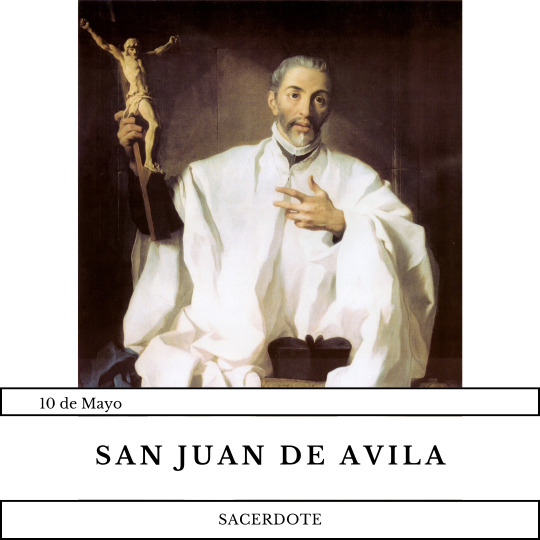
SAN JUAN DE AVILA, SACERDOTE
Un sacerdote español de origen judío, San Juan de Ávila, vivió en el siglo XVI, un período de grandes reformas. Es un místico, gran predicador y consejero de muchos de sus contemporáneos como San Ignacio de Loyola. En 2012 Benedicto XVI lo proclamó Doctor de la Iglesia.
Infancia y formación sacerdotal
San Juan de Ávila nació el 6 de enero de 1499 (o 1500) en Almodóvar del Campo (Ciudad Real), de una familia profundamente cristiana. Sus padres, Alfonso de Ávila (de ascendencia israelita) y Catalina Jijón, poseían unas minas de plata en Sierra Morena, y supieron dar al niño una formación cristiana de sacrificio y amor al prójimo. Son conocidas las escenas de entregar su sayo nuevo a un niño pobre, sus prolongados ratos de oración, sus sacrificios, su devoción eucarística y mariana.
Probablemente en 1513 comenzó a estudiar leyes en Salamanca, de donde volvería después de cuatro años para llevar una vida retirada en Almodóvar. A pesar de llamarlas ‘leyes negras’ los estudios de Salamanca dejaron huella en su formación eclesiástica, como puede constatarse en sus escritos de reforma. Esta nueva etapa en Almodóvar, en casa de sus padres, viviendo una vida de oración y penitencia, durará hasta 1520. Pues aconsejado por un religioso franciscano, marchará a estudiar artes y teología a Alcalá de Henares (1520-1526). De esta etapa en Alcalá existen testimonios de su gran valía intelectual, como así lo atestigua el Mtro. Domingo de Soto. Allí estuvo en contacto con las grandes corrientes de reforma del momento. Conoció el erasmismo, las diversas escuelas teológicas y filosóficas y la preocupación por el conocimiento de las Sagradas Escrituras y los Padres de la Iglesia. También trabó amistad con quienes habían de ser grandes reformadores de la vida cristiana, como don Pedro Guerrero, futuro arzobispo de Granada, y posiblemente también con el venerable Fernando de Contreras. Incluso pudo haber conocido allí al P. Francisco de Osuna y a San Ignacio de Loyola.
Primeros años de sacerdocio
Durante sus estudios en Alcalá, murieron sus padres. Juan fue ordenado sacerdote en 1526, y quiso venerar la memoria de sus padres celebrando su Primera Misa en Almodóvar del Campo. La ceremonia estuvo adornada por la presencia de doce pobres que comieron luego a su mesa. Después vendió todos los bienes que le habían dejado sus padres, los repartió a los pobres, y se dedicó enteramente a la evangelización, empezando por su mismo pueblo.
Un año después, se ofreció como misionero al nuevo obispo de Tlascala (Nueva España), Fr. Julián Garcés, que habría de marchar para América en 1527 desde el puerto de Sevilla. Con este firme propósito de ser evangelizador del Nuevo Mundo, se trasladó san Juan de Ávila a Sevilla, donde mientras tanto se entregó de lleno al ministerio, en compañía de su compañero de estudios en Alcalá el venerable Fernando de Contreras. Ambos vivían pobremente, entregados a una vida de oración y sacrificio, de asistencia a los pobres, de enseñanza del catecismo.
Esta amistad y convivencia con Fernando de Contreras, fueron posiblemente las que motivaron el cambio de las ansias misioneras de Juan de Ávila. El P. Contreras habló con el arzobispo de Sevilla, D. Alonso Manrique, y éste le ordenó a Juan que se quedara en las ‘Indias’ del mediodía español. El mismo arzobispo quiso conocer personalmente la valía del nuevo sacerdote y le mandó predicar en su presencia. Juan de Ávila contaría después la vergüenza que tuvo que pasar; orando la noche anterior ante el crucifijo, pidió al Señor que, por la vergüenza que él pasó desnudo en la cruz, le ayudara a pasar aquel rato amargo. Y cuando, al terminar el sermón, le colmaron de alabanzas, respondió: <<Eso mismo me decía el demonio al subir al púlpito.
Durante algún tiempo continuó el ministerio juntamente con Fernando de Contreras. Pronto se dirigió a predicar y ejercer el ministerio en Écija (Sevilla). Uno de sus primeros discípulos y compañero fue Pedro Fernández de Córdoba, cuya hermana de catorce años, D.ª Sancha Carrillo (ambos hijos de los señores de Guadalcázar, Córdoba), comenzó una vida de perfección bajo la guía del Maestro Ávila. La que habría sido dama de la emperatriz Isabel, pasó a ser (después de confesarse con san Juan de Ávila) una de las almas más delicadas de la época y destinataria de las enseñanzas del Maestro en el Audi, Filia, preciosa pieza espiritual del siglo XVI y único libro escrito por Juan de Ávila. Su predicación se extendía también a Jerez de la Frontera, Palma del Río, Alcalá de Guadaira, Utrera..., juntamente con la labor de confesionario, dirección de almas, arreglo de enemistades.
Pero su presencia en Écija pronto le va a acarrear las enemistades y la persecución. El primer incidente ocurrió cuando un comisario de bulas impidió la predicación de Juan para poder predicar él la bula de que era comisario. El auditorio, sin embargo, dejó al bulero solo en la iglesia principal y fue a escuchar a Juan de Ávila en otra iglesia. Después del suceso, el comisario de bulas, en plena calle, propinó una bofetada a Juan. Éste se arrodilló y dijo humildemente: <<emparéjeme esta otra mejilla, que más merezco por mis pecados>>. Este hecho y las envidias de algunos eclesiásticos, llevaron precisamente a los clérigos a denunciar a San Juan de Ávila ante la Inquisición sevillana en 1531.
Procesado por la Inquisición
Desde 1531 hasta 1533 Juan de Ávila estuvo procesado por la Inquisición. Las acusaciones eran muy graves en aquellos tiempos: llamaba mártires a los quemados por herejes, cerraba el cielo a los ricos, no explicaba correctamente el misterio de la Eucaristía, la Virgen había tenido pecado venial, tergiversaba en sentido de la Escritura, era mejor dar limosna que fundar capellanías, la oración mental era mejor que la oración vocal... Todo menos la verdadera acusación: aquel clérigo no les dejaba vivir tranquilos en su cristianismo o en su vida ‘clerical’. Y Juan fue a la cárcel donde pasó un año entero.
Juan de Ávila no quiso defenderse y la situación era tan grave que le advirtieron que estaba en las manos de Dios, lo que indicaba la imposibilidad de salvación; a lo que respondió: <<No puede estar en mejores manos>>. San Juan fue respondiendo uno a uno todos los cargos, con la mayor sinceridad, claridad y humildad, y un profundo amor a la Iglesia y a su verdad. Y aquél que no quiso tachar a los cinco testigos acusadores, se encontró con que la Providencia le proporción 55 que declararon a su favor.
Este tiempo en la cárcel produjo sus frutos interiores, al igual que lo hiciera con san Juan de la Cruz. En ella escribió un proyecto del Audi, Filia, pero sobre todo, como él nos cuenta, allí aprendió, más que en sus estudios teológicos y vida anterior, el misterio de Cristo. Juan fue absuelto. Pero lo que más humillante fue la sentencia de absolución: “Haber proferido en sus sermones y fuera de ellos algunas proposiciones que no parecieron bien sonantes”, y le mandan, bajo excomunión, que las declare convenientemente, donde las haya predicado.
Viajes y ministerio desde 1535 a 1554
En 1535 marcha Juan de Ávila a Córdoba, llamado por el obispo Fr. Álvarez de Toledo. Allí conoce a Fr. Luis de Granada, con quien entabla relaciones espirituales profundas. Organiza predicaciones por los pueblos (sobre todo por la Sierra de Córdoba), consigue grandes conversiones de personas muy elevadas, entabla buenas relaciones con el nuevo obispo de Córdoba, D. Cristobal de Rojas, que quien dirigirá las Advertencias al Concilio de Toledo.
La labor realizada en Córdoba fue muy intensa. Prestó mucha atención al clero, creando centros de estudios, como el Colegio de San Pelagio (en la actualidad el Seminario Diocesano), el Colegio de la Asunción (donde no se podía dar título de maestro sin haberse ejercitado antes en la predicación y el catecismo por los pueblos). Explica las cartas de san Pablo a clero y fieles. Un padre dominico, que primero se había opuesto a la predicación de san Juan, después de escuchar sus lecciones, dijo: <<vengo de oír al propio san Pablo comentándose a sí mismo.
Córdoba es la diócesis de san Juan de Ávila, tal vez ya desde 1535, pero con toda seguridad desde 1550. Allí le vemos cuando murió D.ª Sancha Carrillo, en 1537, de quien escribió una biografía que se ha perdido. Predica frecuentemente en Montilla, por ejemplo la cuaresma de 1541. Y las célebres misiones de Andalucía (y parte de Extremadura y Castilla la Mancha) las organiza desde Córdoba (hacia 1550-1554). Juan recibiría en Córdoba el modesto beneficio de Santaella, que le vinculó a la diócesis cordobesa para lo restante de su vida. En el Alcázar Viejo de Córdoba reuniría a veinticinco compañeros y discípulos con los que trabajaba en la evangelización de las comarcas vecinas.
A Granada acudió san Juan de Ávila, llamado por el arzobispo D. Gaspar de Avalos, el año 1536. Es en Granada donde tiene lugar el cambio de vida de san Juan de Dios; en la ermita de san Sebastián, oyendo a san Juan de Ávila, Juan Cidad, antiguo soldado y ahora librero ambulante, se convirtió en san Juan de Dios. En numerosas ocasiones san Juan de Dios a Montilla para dirigirse espiritualmente con el Maestro Ávila, convirtiéndose en su más fiel discípulo.
El duque de Gandía, Francisco de Borja, fue otra alma predilecta influida por la predicación de san Juan de Ávila; las honras fúnebres predicadas por éste en las exequias de la emperatriz Isabel (1539) fueron la ocasión providencial que hicieron cambiar de rumbo la vida del futuro general de la Compañía.
En Granada lo vemos formando el primer grupo de sus discípulos más distinguidos. En Granada también, en 1538 están fechadas las primeras cartas de san Juan de Ávila que conocemos. En los años sucesivos vemos a san Juan de Ávila en Córdoba, Baeza, Sevilla, Montilla, Zafra, Fregenal de la Sierra, Priego de Córdoba. La predicación, el consejo, la fundación de colegios, le llevan a todas partes.
La cuaresma de 1545 la predicó en Montilla. Su predicación iba siempre seguida de largas horas de confesionario y de largas explicaciones del catecismo a los niños; éste era un punto fundamental de su programa de predicación.
Los colegios de san Juan de Ávila.
En todas las ciudades por donde pasaba, Juan de Ávila procuraba dejar la fundación de algún colegio o centro de formación y estudio. Sin duda, la fundación más celebre fue la Universidad de Baeza (Jaén). La línea de actuación que allí impuso era común a todos sus colegios, como puede verse plasmada en los Memoriales al Concilio de Trento, donde pide la creación de seminarios, para una verdadera reforma de la Iglesia y del clero.
Predicando el Evangelio.
Es la definición que mejor cuadra a Juan de Ávila: predicador. Éste es precisamente el epitafio que aparece en su sepulcro: “mesor eram”. El centro de su mensaje era Cristo crucificado, siendo fiel discípulo de san Pablo. Predicaba tanto en las iglesias como incluso en las calles. Sus palabras iban directamente a provocar la conversión, la limpieza de corazón. El contenido de su predicación era siempre profundo, con una teología muy escriturística. Pero ésta estaba sobre todo precedida de una intensa oración. Cuando le preguntaban qué había que hacer para predicar bien, respondía: ‘amar mucho a Dios’.
Los textos de los sermones de san Juan de Ávila están acomodados al tiempo litúrgico. Los temas principales son la Eucaristía, el Espíritu Santo, la pasión, el tiempo litúrgico; siendo el tema predilecto para los clérigos el del sacerdocio. La fuerza de su predicación se basaba en la oración, sacrificio, estudio y ejemplo. Podía hablar claro quien había renunciado a varios obispados y al cardenalato, y quien no aceptaba limosnas ni estipendios por los sermones, ni hospedaje en la casa de los ricos o en los palacios episcopales. El desprecio y conocimiento de sí mismo era el secreto para guardar el equilibrio al reprender a los demás, considerándose siempre inferior a los demás.
Su modelo de predicador era san Pablo, al que procuraba imitar sobre todo en el conocimiento del misterio de Cristo. Afirma su biógrafo el Lic. Muñoz que “no predicaba sermón sin que por muchas horas la oración le precediese”, ya que “su principal librería” era el crucifijo y el Santísimo Sacramento.
La misión apostólica de la predicación era precisamente uno de los objetivos de la fundación de sus colegios de clérigos. Ésta era también una de las finalidades de los Memoriales dirigidos al Concilio de Trento.
Retiro en Montilla
Desde 1511 Juan de Ávila se sintió enfermo. Gastado en un ministerio duro, sintió fuertes molestias que le obligaron a residir definitivamente en Montilla desde 1554 hasta su muerte. Rehusó la habitación ofrecida en el palacio de la marquesa de Priego, y se retiró en una modesta casa propiedad de la marquesa. Su vida iba transcurriendo en la oración, la penitencia, la predicación (aunque no tan frecuente), las pláticas a los sacerdotes o novicios jesuitas, la confesión y dirección espiritual, el apostolado de la pluma.
Su enfermedad la ofreció para inmolarse por la Iglesia, a la que siempre había servido con desinterés. Cuando arreciaba más la enfermedad, oraba así: “Señor, habeos conmigo como el herrero: con una mano me tened, y con otra dadme con el martillo”.
Pero a Juan todavía le quedaban quince años de vida fructífera, que empleó avaramente en la extensión del Reino de Dios. El retiro de Montilla le dio la posibilidad de escribir con calma sus cartas, la edición definitiva del Audi, Filia, sus sermones y tratados, los Memoriales al Concilio de Trento, las Advertencias al Concilio de Toledo y otros escritos menores. Se puede decir que Juan de Ávila inicia con sus escritos la mística española del Siglo de oro. Si en otros períodos de su vida se podía calificar de predicador, misionero, fundador de colegios, ahora, en Montilla, se puede resumir su vida diciendo que era escritor.
El Audi, Filia, a pesar de todas las vicisitudes por las que pasó, y tras retocarlo de nuevo en Montilla, queriéndolo confrontar con las enseñanzas de Trento, fue publicado después de su muerte. El rey Felipe II lo apreció tanto que pidió no faltara nunca en El Escorial. El Card. Astorga, arzobispo de Toledo, diría que, con él, “había convertido más almas que letras tiene”. Prácticamente es el primer libro en lengua vulgar que expone el camino de perfección para todo fiel, aun el más humilde. El sentido de perfección cristiana es el sentido eclesial de desposorio de la Iglesia con Cristo. Éste y otros libros de Juan influyeron posteriormente en autores de espiritualidad.
Las cartas de Juan de Ávila llegaban a todos los rincones de España e incluso a Roma. De todas partes se le pedía consejo. Obispos, santos, personas de gobierno, sacerdotes, personas humildes, enfermos, religiosos y religiosas, eran los destinatarios más frecuentes. Las escribía de un tirón, sin tener tiempo para corregirlas. Llenas de doctrina sólida, pensadas intensamente, con un estilo vibrante.
No hay en todo el siglo XVI ningún autor de vida espiritual tan consultado como Juan de Ávila. Examinó la Vida de santa Teresa, se relacionó frecuentemente con san Ignacio de Loyola o con sus representantes, con san Francisco de Borja, san Juan de Dios, san Pedro de Alcántara, San Juan de Ribera, fray Luis de Granada.
A Juan de Ávila se le llama <<reformador>>, si bien sus escritos de reforma se ciñen a los Memoriales para el Concilio de Trento, escritos para el arzobispo de Granada, D. Pedro Guerrero, ya que Juan de Ávila no pudo acompañarle a Trento debido a su enfermedad, y a las Advertencias al Concilio de Toledo, escritas para el obispo de Córdoba, D. Cristóbal de Rojas, que habrían de presidir el Concilio de Toledo (1565), para aplicar los decretos tridentinos.
La doctrina de san Juan de Ávila sobre le sacerdocio quedó esquematizada en un Tratado sobre el sacerdocio, del que conocemos sólo una parte, pero una belleza y contenido extraordinarios, y que sirvió de pauta para sus pláticas y retiros a clérigos, y para que sus discípulos hicieran otro tanto donde no podía llegar ya el Maestro.
Escuela Sacerdotal
Este término aparece con frecuencia en las primeras biografías de nuestro santo, para referirse a sus discípulos. Todos ellos tienen un denominador común, a pesar de ministerios muy diversos y de encontrarse en lugares muy distantes: predicar el misterio de Cristo, enderezar las costumbres, renovación de la vida sacerdotal según los decretos conciliares, no buscar dignidades ni puestos elevados, vida intensa de oración y penitencia, paciencia en las contradicciones y persecuciones, sentido de Iglesia, enseñar la doctrina cristiana, dirección espiritual, etc. Los encontramos en los pueblecitos más alejados de pastores y agricultores como en las aldeas de Fuenteovejuna, como entre los consejeros de los grandes; en los colegios y universidades o en las costas de Andalucía; en las prelaturas o en las minas de Almadén.
El grupo sacerdotal de Juan de Ávila parece que se estructura en Granada hacia el año 1537, aunque ya antes se habían hecho discípulos suyos algunos sacerdotes de Sevilla, Écija y Córdoba. En Córdoba reunió a más de veinte en el Alcázar Viejo. Y fue allí donde dirigió un centro misional durante ocho o nueve años. La gran misión del mediodía español es una de las manifestaciones típicas de la escuela sacerdotal de Juan de Ávila.
La escuela sacerdotal de Juan de Ávila no se puede estudiar sino teniendo a la vista la relación con la Compañía de Jesús. Juan encaminó a muchos de sus discípulos a la Compañía, y hubo intentos de fusión, cesión de colegios, estudio conjunto, ayuda a los jesuitas, que en Salamanca encontraron muchas dificultades. Pero Juan de Ávila no entró en la Compañía. Éste era el gran deseo de san Ignacio, hasta el punto de afirmar que “o nosotros nos unamos a él o él a nosotros”. Pero la voluntad del Señor no era ésta, la enfermedad de Juan y los caminos del Señor lo impidieron. A pesar de ello, él fue enviando a sus mejores discípulos a la Compañía.
La escuela sacerdotal avilista ser refleja principalmente en su Maestro. El testimonio y la doctrina de Juan dejaron huella imborrable, como le iba dejando su sello personal que tenía dibujado el Santísimo Sacramento. En sus discípulos dejó impresa la ilusión por la vocación sacerdotal, el amor al sacerdocio, con los matices de la vida eucarística, vida litúrgica y de oración personal profunda, devoción al Espíritu Santo, a la Pasión del Señor, a la Virgen María, entrega total al servicio desinteresado de la Iglesia en la expansión del Reino y la predicación de la Palabra de Dios. Pero lo que consideraba esencial en todo aquel que quería ser buen sacerdote era la vida de oración, ya que en la caridad y en la oración era en los que según él habrían de consistir los exámenes de Órdenes.
En la Santa Misa centraba toda la evangelización y vida sacerdotal. La celebraba empleando largo tiempo, con lágrimas por sus pecados. Sobre la Eucaristía jamás le faltó materia para predicar, especialmente en la fiesta y octava del Corpus. “Trátalo bien, que es hijo de buen Padre”, dijo a un sacerdote de Montilla que celebraba con poca reverencia; la corrección tuvo como efecto conquistar un nuevo discípulo. Ya enfermo en Montilla, quiso ir a celebrar misa a una ermita; por el camino se sintió imposibilitado; el Señor, en figura de peregrino, se le apareció y le animó a llegar hasta la meta. Fue el gran apóstol de la comunión frecuente, a pesar de las contradicciones que se le siguieron. Prefería la presencia eucarística a la visita de los Santos Lugares.
Su virtud principal fue la caridad. Tenía un amor entrañable a la humanidad de Cristo: “el Verbo encarnado fue el libro y juntamente maestro”. Su Tratado del amor de Dios es una joya de la literatura teológica en lengua castellana. Su amor al prójimo fue la expresión del ministerio sacerdotal. Toda la obra de Juan de Ávila mira hacia la caridad cristiana. De ahí la preocupación por la educación cristiana y humana integral, la preocupación por los problemas sociales, por la reforma del estado seglar (como él decía), por la reforma del clero.
Una cruz grande de palo en su habitación de Montilla, la renuncia a las prebendas y obispados (el de Segovia y Granada), así como el capelo cardenalicio (ofrecido por Paulo III), son índice de la pobreza y humildad de quien “fue obrero sin estipendio..., y habiendo servido tanto a la Iglesia, no recibió de ella un real” (Lic. Muñoz). No renunció al episcopado por desprecio, sino por imitar al Señor y por sentirse indigno. Su amor a la pobreza no tiene otra motivación sino un amor profundo a Jesucristo. Asistía a los pobres. Vivía limpia y pobremente y no consiguieron cambiarle el manteo o la sotana ni aun con engaño.
Su humildad le llevó a ser un verdadero reformador. No pudieron sacarle ningún retrato. Su predicación iba siempre acompañada del catecismo a los niños; su método catequético tiene sumo valor en la historia de la pedagogía.
El celo por la extensión del Reino aparece en sus obras y palabras. Las cartas a los predicadores son pura llama de apóstol. No admitía que murmurasen de nadie. La castidad la veía en relación al sacerdocio, principalmente como ministro de la Eucaristía. La devoción a María la expresa continuamente y la aconseja a todo el mundo.
De todas sus virtudes, de su prudencia, consejo, discreción, etc., hablan sus biógrafos. Pero él conocía bien sus propios defectos y, por eso, pidió en las últimas horas de su vida que no le hablaran de cosas elevadas, sino que le dijeran lo que se dice a los que van a morir por sus delitos. A Juan de Ávila no le atraían propiamente las virtudes en sí mismas, sino el misterio de Cristo vivido y predicado.
Entregado al estudio continuo de las Escrituras y de otras materias eclesiásticas, gastando su vida en la oración, predicación y fundación de obras apostólicas y sociales, en la dirección de las almas y en la enseñanza del catecismo, en la formación de sacerdotes y futuros sacerdotes, Juan de Ávila es un maestro de apóstoles.
La figura personal y pastoral de Juan de Ávila encontró pronto eco en Italia con san Carlos Borromeo, y en Francia en la escuela sacerdotal francesa del siglo XVII. Pero su obra quedó, en parte, en la tiniebla en su aportación más profunda a la vida evangélica precisamente para el clero diocesano y la vida de perfección cristiana en las estructuras de todo el pueblo de Dios.
Muerte de Juan de Ávila.
La estancia definitiva en Montilla fue especialmente fructífera. Dejó una huella imborrable en los sacerdotes de la ciudad. En una de sus últimas celebraciones de la misa le hablo un hermoso crucifijo que él veneraba: “perdonados te son tus pecados”.
Pero la enfermedad iba pudiendo más que su voluntad. A principio de mayo de 1569 empeoró gravemente. En medio de fuertes dolores se le oía rezar: “Señor mío, crezca el dolor, y crezca el amor, que yo me deleito en el padecer por vos”. Pero en otras ocasiones podía la debilidad: “¡Ah, Señor, que no puedo!”. Una noche, cuando no podía resistir más, pidió al Señor le alejara el dolor, como así se hizo en efecto; por la mañana, confundido, dijo a los suyos: “¡Qué bofetada me ha dado Nuestro Señor esta noche!”.
Juan de Ávila no hizo testamento, porque dijo que no tenía nada que testar. Pidió que celebraran por él muchas misas; rogó encarecidamente que le dijeran lo que se dice a quienes van a morir por sus delitos. Quiso que se celebrara la misa de resurrección en aquellos momentos en que se encontraba tan mal. Manifestó el deseo de que su cuerpo fuera enterrado en la iglesia de los jesuitas, pues a los que tanto había querido en vida, quiso dejarles su cuerpo en muerte. Quiso recibir la Unción con plena conciencia. Invocó a la Virgen con el Recordare, Virgo Mater... Y una de sus últimas palabras mirando el crucifijo, fue “ya no tengo pena de este negocio”. Era el 10 de mayo de 1569. Santa Teresa, al enterarse de la muerte de Juan de Ávila, se puso a llorar y, preguntándole la causa, dijo: “Lloro porque pierde la Iglesia de Dios una gran columna”.
La persona, los escritos, la obra y los discípulos de Juan de Ávila influirán en los siglos posteriores. Hemos visto los santos y autores que estuvieron relacionados más o menos con san Juan de Ávila; casi todos ellos influenciados por sus escritos, por su persona o por su obra. Se suelen encontrar, además, vestigios de influencia místico-poética en san Juan de la Cruz y en Lope de Vega. San Francisco de Sales y san Alfonso Mª de Ligorio citan frecuentemente a san Juan de Ávila. Y san Antonio Mª Claret reconocía el bien que le hicieron los escritos de san Juan de Ávila como predicador. Su influencia es notoria en la escuela francesa de espiritualidad sacerdotal, en cuyos escritos y doctrina se inspiraron.
En 1588, Fr. Luis de Granada, recogiendo algunos escritos enviados por los discípulos y recordando su propia convivencia con san Juan de Ávila, escribió la primera biografía. En 1623, la Congregación de san Pedro Apóstol, de sacerdotes naturales de Madrid, inicia la causa de beatificación. En 1635, el Licdo. Luis Muñoz escribe la segunda biografía de Juan de Ávila, basándose en la de Fr. Luis, en los documentos del proceso de beatificación y en algunos documentos que se han perdido. El día 4 de abril de 1894, León XIII beatifica al Maestro Ávila. Pío XII, el 2 de julio de 1946 lo declara Patrono del clero secular español. Pero el maestro de santos tendrá que esperar hasta el año 1970 para ser canonizado por el Papa Pablo VI.
La iglesia de la Compañía de Montilla, donde descansan sus restos, y la pequeña casa donde vivió sus últimos años san Juan de Ávila, son centros de continuo peregrinar de obispos, sacerdotes y fieles de toda España.
La Conferencia Episcopal Española ha pedido a la Santa Sede, con motivo del centenario del nacimiento de san Juan de Ávila, que sea declarado Doctor de la Iglesia Universal. Esperamos que aquél que ha sido conocido a lo largo de los últimos cinco siglos como el Maestro, pronto le sea reconocido por la Iglesia oficial el título de Doctor y Maestro del pueblo cristiano.
2 notes
·
View notes
Text
Generation of 27
The Generation of '27 (Spanish: Generación del 27) was an influential group of poets that arose in Spanish literary circles between 1923 and 1927, essentially out of a shared desire to experience and work with avant-garde forms of art and poetry. Their first formal meeting took place in Seville in 1927 to mark the 300th anniversary of the death of the baroque poet Luis de Góngora. Writers and intellectuals paid homage at the Ateneo de Sevilla, which retrospectively became the foundational act of the movement.
Terminology:
The Generation of '27 has also been called, with lesser success, "Generation of the Dictatorship", "Generation of the Republic", "Generation Guillén-Lorca" (Guillén being its oldest author and Lorca its youngest), "Generation of 1925" (average publishing date of the first book of each author), "Generation of Avant-Gardes", "Generation of Friendship", etc. According to Petersen, "generation group" or a "constellation" are better terms which are not so much historically restricted as "generation".
Aesthetic style:
The Generation of '27 cannot be neatly categorized stylistically because of the wide variety of genres and styles cultivated by its members. Some members, such as Jorge Guillén, wrote in a style that has been loosely called jubilant and joyous and celebrated the instant, others, such as Rafael Alberti, underwent a poetic evolution that led him from youthful poetry of a more romantic vein to later politically-engaged verses.
The group tried to bridge the gap between Spanish popular culture and folklore, classical literary tradition and European avant-gardes. It evolved from pure poetry, which emphasized music in poetry, in the vein of Baudelaire, to Futurism, Cubism, Ultraistand Creationism, to become influenced by Surrealism and finally to disperse in interior and exterior exile following the Civil Warand World War II, which are sometimes gathered by historians under the term of the "European Civil War". The Generation of '27 made a frequent use of visionary images, free verses and the so-called impure poetry, supported by Pablo Neruda.
Members:
In a restrictive sense, the Generation of '27 refers to ten authors, Jorge Guillén, Pedro Salinas, Rafael Alberti, Federico García Lorca, Dámaso Alonso, Gerardo Diego, Luis Cernuda, Vicente Aleixandre, Manuel Altolaguirre and Emilio Prados. However, many others were in their orbit, some older authors such as Fernando Villalón, José Moreno Villa or León Felipe, and other younger authors such as Miguel Hernández. Others have been forgotten by the critics, such as Juan Larrea, Pepe Alameda, Mauricio Bacarisse, Juan José Domenchina, José María Hinojosa, José Bergamín or Juan Gil-Albert. There is also the "Other generation of '27", a term coined by José López Rubio, formed by himself and humorist disciples of Ramón Gómez de la Serna, including: Enrique Jardiel Poncela, Edgar Neville, Miguel Mihura and Antonio de Lara, "Tono", writers who would integrate after the Civil War (1936–39) the editing board of La Codorniz.
Furthermore, the Generation of '27, as clearly reflected in the literary press of the period, was not exclusively restricted to poets, including artists such as Luis Buñuel, the caricaturist K-Hito, the surrealist painters Salvador Dalí and Óscar Domínguez, the painter and sculptor Maruja Mallo, as well as Benjamín Palencia, Gregorio Prieto, Manuel Ángeles Ortiz and Gabriel García Maroto, the toreros Ignacio Sánchez Mejías and Jesús Bal y Gay, musicologists and composers belonging to the Group of Eight, including Bal y Gay, Ernesto Halffter and his brother Rodolfo Halffter, Juan José Mantecón, Julián Bautista, Fernando Remacha, Rosa García Ascot, Salvador Bacarisse and Gustavo Pittaluga. There was also the Catalan Group who presented themselves in 1931 under the name of Grupo de Artistas Catalanes Independientes, including Roberto Gerhard, Baltasar Samper, Manuel Blancafort, Ricard Lamote de Grignon, Eduardo Toldrá and Federico Mompou.
Finally, not all literary works were written in Spanish: Salvador Dalí and Óscar Domínguez also wrote in French. Foreigners such as the Chilean poets Pablo Neruda and Vicente Huidobro, the Argentine writer Jorge Luis Borges, and the Franco-Spanish painter Francis Picabia also shared much with the aesthetics of the Generation of '27.
The Generation of '27 was not exclusively located in Madrid, but rather deployed itself in a geographical constellation which maintained links together. The most important nuclei were in Sevilla, around the Mediodía review, Tenerife around the Gaceta de Arte, and Málaga around the Litoral review. Others members resided in Galicia, Catalonia and Valladolid.
The Tendencies of '27:
The name "Generation of 1927" identifies poets that emerged around 1927, the 300th anniversary of the death of the Baroque poet Luis de Góngora y Argote to whom the poets paid homage. It sparked a brief flash of neo-Gongorism by outstanding poets like Rafael Alberti, Vicente Aleixandre, Dámaso Alonso, Luis Cernuda, Gerardo Diego and Federico García Lorca.
Spanish Civil War aftermath:
The Spanish Civil War ended the movement: García Lorca was murdered, Miguel Hernandez died in jail and other writers (Rafael Alberti, Jose Bergamin, León Felipe, Luis Cernuda, Pedro Salinas, Juan Ramón Jiménez, Bacarisse) were forced into exile, although virtually all kept writing and publishing late throughout the 20th century.
Dámaso Alonso and Gerardo Diego were among those who reluctantly remained in Spain after the Francoists won and more or less reached agreements with the new authoritarian and traditionalist regime or even openly supported it, in the case of Diego. They evolved a lot, combining tradition and avant-garde, and mixing many different themes, from toreo to music to religious and existentialist disquiets, landscapes, etc. Others, such as Vicente Aleixandre and Juan Gil-Albert, simply ignored the new regime, taking the path of interior exile and guiding a new generation of poets.
However, for many Spaniards the harsh reality of Francoist Spain and its reactionary nature meant that the cerebral and aesthetic verses of the Generation of '27 did not connect with what was truly happening, a task that was handled more capably by the poets of the Generation of '50 and the social poets.
Statue:
A statue dedicated to the Generation 27 Poets is now in Seville in Spain. The inscription on the monument translates as 'Seville The poets of the Generation of 27'
List of members[edit]
Rafael Alberti (1902–1999)
Vicente Aleixandre (1898–1984)
Amado Alonso (1897–1952)
Dámaso Alonso (1898–1990)
Manuel Altolaguirre (1905–1959)
Francisco Ayala (1906–2009)
Mauricio Bacarisse (1895–1931)
José Bello (1904–2008)
Rogelio Buendía (1891–1969)
Alejandro Casona (1903–1965)
Juan Cazador (1899–1956)
Luis Cernuda (1902–1963)
Juan Chabás (1900–1954)
Ernestina de Champourcín (1905–1999)
Gerardo Diego (1896–1987)
Juan José Domenchina (1898–1959)
Antonio Espina (1894–1972)
Agustín Espinosa (1897–1939)
León Felipe (1884–1968)
Agustín de Foxá (1903–1959)
Pedro García Cabrera (1905–1981)
Federico García Lorca (1898–1936)
Pedro Garfias (1901–1967)
Juan Gil-Albert (1904–1994)
Ernesto Giménez Caballero (1899–1988)
Jorge Guillén (1893–1984)
Emeterio Gutiérrez Albelo (1905–1937)
Miguel Hernández (1910–1942)
José María Hinojosa (1904–1936)
Enrique Jardiel Poncela (1901–1952)
Rafael Laffón (1895–1978)
Antonio de Lara (1896–1978)
Juan Larrea (1895–1980)
José López Rubio (1903–1996)
José María Luelmo (1904–1991)
Francisco Madrid (1900–1952)
Paulino Masip (1899–1963)
Concha Méndez (1898–1986)
Miguel Mihura (1905–1977)
Edgar Neville (1899–1967)
Antonio Oliver (1903–1968)
Pedro Pérez-Clotet (1902–1966)
Rafael Porlán (1899–1945)
Emilio Prados (1899–1962)
Joaquín Romero Murube (1904–1969)
Pedro Salinas (1891–1951)
Guillermo de Torre (1900–1971)
José María Souvirón (1904–1973)
Miguel Valdivieso (1897–1966)
Fernando Villalón (1881–1930)
13 notes
·
View notes
Text

is that ODESSA A’ZION ? oh, no, that’s JULIA “JULES” LEVENTHAL, a TWENTY-FOUR year old SCUBA / SNORKEL GUIDE & COMPETITIVE SURFER . . .

* ◟ : 𝚂𝚃𝙰𝚃𝙸𝚂𝚃𝙸𝙲𝚂 ﹗
FULL NAME: julia simone leventhal rojas NICKNAMES / ALIAS: jules, juli, julita AGE: twenty four GENDER / PRONOUNS: demi woman / she/they SEXUALITY: pansexual ZODIAC: sag sun , libra moon BIRTHDATE & BIRTHPLACE: dec 5th 1999 & kennebunkport, maine, usa CURRENT RESIDENCE: still living with their mom, stepfather, & half-siblings in viña del mar EDUCATION: high school diploma ; divemaster certification SPOKEN LANGUAGES: english, spanish, some french & brazilian portuguese OCCUPATION: scuba / snorkel guide & aspiring competitive surfer
* ◟ : 𝙱𝙰𝙲𝙺𝚂𝚃𝙾𝚁𝚈 ﹗
jules doesn’t have many memories of the beginning of her life in a small coastal town in southern maine. raised by grandparents and a single mother the first nine years of her life, her mother—hannah—yearned to get out of the small town life and explore the world with her child. that’s when she got the opportunity of a lifetime — jules’ godmother, angela, invited hannah and jules on an excursion to the patagonia region of chile. opened a Third Eye for jules tbh for their love of travel and the outdoors. truly jules’ element
hannah not only fell in love with the country, extending her winter (or summer in the southern hemisphere) holiday trip with nine-year-old jules to travel around with her best friend and experience the vibrant culture of chile, but she fell in love !
jules’ mother met alonso in viña del mar. he was her dive guide ( while jules stayed behind at the family owned diving center / restaurant with her future grandmother, cristal, and older step-brother, ignacio ) and the two were inseparable ever since. next thing jules knows, their mother is getting married and they are both getting citizenship to become chileans !
not only did their mother discover that chile was her home, but so did jules. the pacific ocean is just where jules belongs. ignacio and jules were two peas in a pod and alonso became the father - figure that jules was missing out on. the two of them introduced jules to surfing & scuba diving, and she fell in love with it and they were pretty impressed with how quickly she caught onto it.
jules’ family grows bigger as time goes on, growing from a family of four to a family of seven. her dreams in becoming a professional surfer grows as she is entered in junior surfing competitions across the chilean coast and earning several accolades throughout her teenage years.
all on jules’ mind are a few things: surfing, getting some rays, looking after their younger brothers, playing beach volleyball, going out for beers, making jewelry out of shells and handmade beads, eating some of fruit … not much else. they’re pretty content working at the rojas diving center with their step-father and coworkers they’ve known for years.
hannah wanted her child to go to some sort of higher education, and to appease her mother, jules attended a nearby university to get a degree in marine biology only to help educate tourists and volunteer her time to help the actually trained ecologists with their restoration / research work
as of the present day, jules is very well-known in the surfing community of chile for her talent. they've even entered competitions in the neighboring peru and took a sabbatical to surf with friends in brazil. most recently, she competed for chile in the pan american games that was hosted in chile last year and got a silver medal !!! perhaps this is the beginning of jules’ professional career and an in to the world surfing league :eyes:
3 notes
·
View notes
Photo

When I started work on a photomorph of a character from Oliver and Company, most people would expect someone like Georgette. But I decided to go for a character who’s more underappreciated when it comes to fan art. And that character was Tito.
At first, I didn’t think Tito would be a nice fit for this. But after looking at this again, I feel like I made an excellent choice. He his headband goes great with the jacket!
Sorry furries Georgette fans. You’ll just have to get your precious poddle photomorphs from an artist who does more dirty work.
Original image: https://www.thefashionisto.com/wp-content/uploads/2014/04/macys-american-icons-ryan-lochte-calvin-klein-photos-006.jpg
#oliver and company#Ignacio Alonso Julio Federico de Tito#chihuahua#dog#canine#anthro#anthropomorphic#photo manipulation#photomorph#Disney#Furries#I await your complaints in the ask box
1 note
·
View note
Text

THE END IS NEAR ...
the following characters have not been seen in hawkins for more than +7 days without knowledge. they have 24hrs to contact the admins or continue with activity or they will be removed & reopened for applications.
CHRISSY CUNNINGHAM
DUSTIN HENDERSON
IGNACIO ALONSO
JOYCE BYERS
QUINN CRICHTON
THEODORA REYES
RESHAPE THE WORLD ...
the following characters have been seen throughout hawkins but inconsistently without admin knowledge. they are not available for applications.
ALAN MUNSON ( inconsistent with text & para requirement )
BEN RUTHERFORD ( inconsistent with text & para requirement )
ELLIOT GRAVES ( inconsistent with text, group chat, & para requirement )
JIM HOPPER ( inconsistent with text & para requirement )
ROBIN BUCKLEY ( inconsistent with text & para requirement )
STEVE HARRINGTON ( inconsistent with text requirement )
VISK PAIZ ( inconsistent with text, group chat, & para requirement )
0 notes
Text
Nike and Uruguayan Football Association Forge Multi-Year Partnership

Nike and the Uruguayan Football Association (AUF) have officially announced a multi-year partnership, establishing Nike as the federation’s exclusive sports sponsor and supplier.
This collaboration extends across all AUF men’s and women’s national football teams, as well as Olympic, beach football, futsal, and e-sports teams, showcasing Nike’s commitment to supporting diverse forms of the sport.
Empowering Football in Latin America
The partnership is designed to drive football’s growth in Latin America, with a strong focus on grassroots initiatives and youth development. Through community impact programs, Nike aims to inspire the next generation of players while reinforcing its dedication to growing the game globally.
Doug Bowles, Nike’s VP/GM for Latin America, emphasized the significance of this partnership:
“The Uruguayan Football Association is a powerhouse in Latin American football. This partnership underscores our deep commitment to fueling the passion for football in the region and across Latin America, particularly among youth. We look forward to partnering with the federation to serve players and supporters with Nike’s one-of-a-kind innovation and design.”
A Shared Vision for Progress
Nike and the AUF share a vision to elevate football participation and access in Uruguay. Their collaboration will focus on enhancing local football programs, coaching education, and using the power of sport to drive social change.
Ignacio Alonso, President of the AUF, shared his excitement about the partnership:
“We are delighted to join forces with Nike, a global leader in sports innovation. We share Nike’s vision for a more inclusive and vibrant football ecosystem in Latin America, and together, we’ll work tirelessly to ensure football becomes a catalyst for positive change in Uruguay and beyond.”
The Next Era of Uruguayan Football
The Uruguayan men’s national team debuted Nike kits this summer, marking a new chapter in the nation’s football history. Fans can look forward to experiencing Nike’s cutting-edge designs in national team kits and other apparel celebrating Uruguay’s iconic Celeste.
Uruguayan star Federico Valverde expressed his enthusiasm:
“It’s not just about looking sharp, it’s about performing at our best. The innovation and design that Nike brings to the table is unmatched and helps us stay focused throughout the game.”
A Global Commitment to Sport
This partnership aligns with Nike’s broader mission to expand access to sport worldwide. Recent initiatives include opening a Playground for All in Korea, promoting girls’ access to sport in France and Japan, and hosting Coach the Dream summits globally.
With this partnership, Nike continues to lead in advancing football’s reach and impact, ensuring a brighter future for athletes in Uruguay and beyond.

0 notes